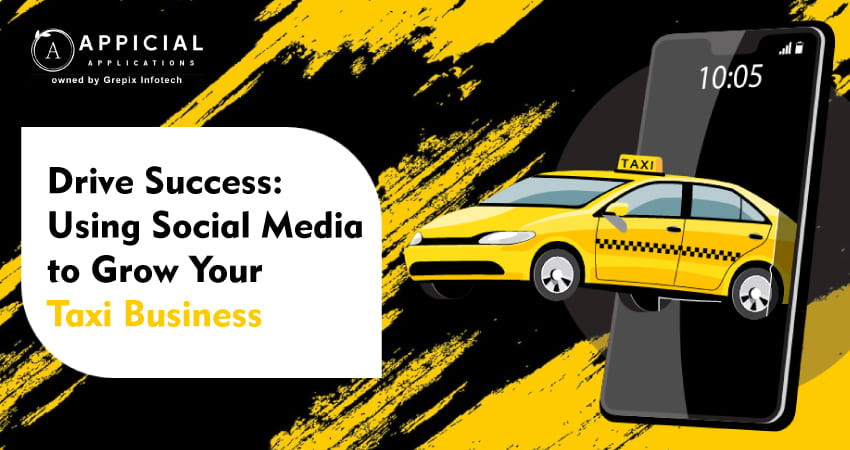
Drive Success: Using Social Media to Grow Your Taxi Business
Imagine a city where the streets never sleep, the lights shimmer on rain-kissed roads, and people rush to catch early morning flights, late-night work rides, or quick family hospital visits. Among them, a local taxi service once struggled to get noticed, lost in a sea of competitors and noisy billboards that no one stopped to read. Then, something shifted.
One Instagram post, capturing a smiling driver helping an elderly woman with her groceries, went viral in the local community. Within a week, the taxi company saw a 40% spike in bookings, drivers felt more valued, and passengers started tagging the company on their own stories, sharing safe rides and small kindnesses they experienced.
This is not just a feel-good story; it is the real power of social media, and it is rewriting the growth story of taxi businesses worldwide. In today’s fast-paced digital ecosystem, the success of your taxi business is no longer limited to how many cars you have on the road. It’s about how many screens you appear on, how many conversations you are a part of, and how authentically you can connect with people who need your service. Social media isn’t just a tool; it’s your ticket to increased visibility, customer trust, and consistent growth.
If you are a startup aiming to conquer your city or an established taxi business ready to expand your reach, this blog will guide you step-by-step on how to harness social media to drive real, sustainable success.
In today's digital age, social media is crucial for the growth of taxi businesses. Platforms like Facebook, Instagram, Twitter, and LinkedIn offer unparalleled opportunities to increase visibility, engage customers, and drive bookings. Effective social media strategies include defining goals, understanding the target audience, choosing the right platforms, creating engaging content, and leveraging paid advertising. Engaging with customers and monitoring performance using analytics tools are also essential. By staying ahead of trends like video content, influencer marketing, and social commerce, taxi businesses can maximize their reach and success through social media marketing.
Understanding the Importance of Social Media for Taxi Businesses
Social media platforms offer taxi businesses a direct line of communication with both existing and potential customers. This dynamic interaction can significantly enhance brand visibility and customer engagement, crucial components in the highly competitive taxi industry. By leveraging social media, taxi businesses can achieve the following:
- Increased Brand Awareness: Regular and strategic posts can keep your brand at the forefront of customers' minds.
- Customer Engagement: Engaging content and interactions can build a community around your brand.
- Targeted Advertising: Social media platforms offer robust advertising tools to reach specific demographics.
- Customer Feedback and Improvement: Platforms provide a space for customers to leave feedback, which can be used to improve services.
- Cost-Effective Marketing: Compared to traditional marketing, social media marketing can be more affordable and have a higher return on investment (ROI).
Creating a Solid Social Media Strategy
A well-defined social media strategy is essential for success. Here's a step-by-step approach to crafting an effective strategy for your taxi business:
1. Define Your Goals
Start by identifying what you want to achieve with your social media efforts. Common goals include:
- Increasing brand awareness
- Driving website traffic
- Generating leads
- Boosting customer engagement
- Enhancing customer service
- Promoting special offers or services
2. Know Your Audience
Understanding your target audience is crucial. Determine who your ideal customers are, where they spend their time online, and what type of content resonates with them. Factors to consider include age, location, interests, and online behavior.
Also Read: Top 7 App Development Concepts for Startups to Thrive in 2024
3. Choose the Right Platforms
Not all social media platforms are created equal. Each has its unique strengths and user demographics. Focus on the platforms that align with your business goals and target audience:
- Facebook: Ideal for reaching a broad audience and promoting community engagement.
- Instagram: Great for sharing visually appealing content and engaging with younger demographics.
- Twitter: Useful for real-time updates, customer service, and engaging in industry conversations.
- LinkedIn: Best for B2B marketing and connecting with corporate clients.
4. Create Engaging Content
Content is the backbone of your social media strategy. It should be diverse, engaging, and aligned with your brand's voice. Types of content to consider include:
- Educational Posts: Share tips on safe travel, local attractions, and travel hacks.
- Promotional Content: Advertise special offers, discounts, and loyalty programs.
- Customer Testimonials: Showcase positive reviews and testimonials from satisfied customers.
- Behind-the-Scenes: Give followers a glimpse into your business operations and team.
- User-Generated Content: Encourage customers to share their experiences using your services.
Leveraging Advertising and Promotions
Paid advertising on social media platforms can significantly amplify your reach and impact. Here's how to make the most of social media advertising:
- Facebook Ads Facebook offers a robust advertising platform with various ad formats, including photo ads, video ads, carousel ads, and more. Use Facebook Ads Manager to create targeted campaigns based on demographics, interests, and behaviors. Retargeting ads can also help re-engage users who have previously interacted with your brand.
- Instagram Ads Instagram, owned by Facebook, uses the same Ads Manager, making it easy to run campaigns across both platforms. Utilize visually appealing images and videos, and leverage Instagram Stories for time-sensitive promotions and updates.
- Twitter Ads Twitter Ads can help you reach users based on keywords, interests, and followers of specific accounts. Promoted Tweets and Twitter Cards are effective for driving engagement and website traffic.
- LinkedIn Ads LinkedIn's advertising platform is ideal for B2B marketing. Sponsored Content, InMail, and Text Ads can help you connect with corporate clients and promote your business services.
Engaging with Your Audience
Social media is not just about broadcasting your message; it's about engaging in meaningful conversations with your audience. Here are some tips for effective engagement:
- Respond Promptly Timely responses to comments, messages, and reviews show that you value your customers' input. Aim to respond within a few hours, especially for inquiries related to bookings and customer service.
- Foster Community Encourage interactions among your followers by asking questions, creating polls, and hosting contests. This not only increases engagement but also builds a sense of community around your brand.
- Handle Negative Feedback Gracefully Negative feedback is inevitable, but how you handle it can make a significant difference. Address complaints promptly and professionally, offering solutions where possible. This shows that you care about your customers' experiences and are committed to improving your services.
Monitoring and Analyzing Performance
To ensure your social media efforts are effective, regularly monitor and analyze your performance. Use analytics tools provided by social media platforms to track key metrics such as engagement, reach, and conversion rates. This data can help you refine your strategy and make informed decisions.
- Facebook Insights Facebook Insights provides detailed metrics on your page's performance, including post reach, engagement, and audience demographics. Use this data to identify which types of content resonate most with your audience.
- Instagram Insights Instagram Insights offers similar metrics, including impressions, reach, and engagement for your posts and stories. Analyze this data to understand what content drives the most interaction.
- Twitter Analytics Twitter Analytics provides data on tweet impressions, engagement rates, and follower growth. Use these insights to optimize your tweeting schedule and content strategy.
- LinkedIn Analytics LinkedIn Analytics offers insights into your page's performance, including visitor metrics, update engagement, and follower demographics. Leverage this data to enhance your LinkedIn presence and engagement.
Real-Life Success Stories
To illustrate the power of social media marketing, let's explore a few real-life success stories of taxi businesses that have effectively leveraged these platforms.
1. Uber
Uber's success can be attributed in part to its savvy social media marketing. The company uses social media to engage with customers, promote new features, and share user-generated content. Uber's WhereTo campaign, which encouraged users to share their travel stories, generated significant engagement and brand loyalty.
2. Lyft
Lyft has built a strong social media presence by focusing on community and customer engagement. The company frequently shares stories of their drivers and passengers, humanizing the brand and fostering a sense of community. Lyft also uses social media for customer service, responding promptly to inquiries and feedback.
3. Local Taxi Services
Smaller, local taxi services have also found success with social media marketing. For example, a taxi company in New York City used Instagram to showcase iconic cityscapes and promote special offers, resulting in increased bookings and brand awareness. By engaging with local influencers and encouraging user-generated content, the company built a loyal customer base and boosted its online presence.
Future Trends in Social Media Marketing for Taxi Businesses
As social media continues to evolve, taxi businesses must stay ahead of emerging trends to remain competitive. Here are a few trends to watch:
- Video Content Video content is becoming increasingly popular on social media. Short-form videos on platforms like TikTok and Instagram Reels, as well as live streaming on Facebook and Instagram, can help taxi businesses engage with their audience in new and exciting ways.
- Influencer Marketing Partnering with influencers can help taxi businesses reach a broader audience. Influencers can promote your services to their followers, providing authentic endorsements that resonate with potential customers.
- Social Commerce Social media platforms are increasingly integrating shopping features, allowing businesses to sell products and services directly through their profiles. Taxi businesses can use these features to offer promotions, sell merchandise, or even allow customers to book rides directly through social media.
- Enhanced Analytics Advanced analytics tools are becoming more accessible, enabling businesses to gain deeper insights into their social media performance. These tools can help taxi businesses refine their strategies and achieve better results.
Conclusion
Social media has become an essential tool for taxi business aiming to expand their reach and enhance their brand presence. By leveraging platforms like Facebook, Instagram, Twitter, and LinkedIn, you can connect with a broader audience, engage with customers in real-time, and drive more bookings. A robust social media strategy, engaging content, targeted advertising, and consistent interaction with your audience are key to success. Additionally, monitoring performance and staying ahead of trends will help you refine your approach and achieve better results. Embrace the power of social media to elevate your taxi business, ensuring sustained growth and customer loyalty in the competitive digital landscape.
This is where Appicial Applications becomes your growth partner. As a leading taxi app development company, Appicial offers advanced Uber like taxi app solutions designed to streamline your bookings, enhance customer experience, and integrate easily with your social media marketing initiatives. Whether you want in-app promotions, customer notifications linked to your Facebook campaigns, or WhatsApp-based ride confirmations, Appicial ensures you stay ahead in your market while focusing on what you do best: providing safe, reliable rides to your customers.
Looking out to start your own venture like Uber? Try out our HireMe Taxi Uber Clone, the easiest way to kick-start your taxi business.





